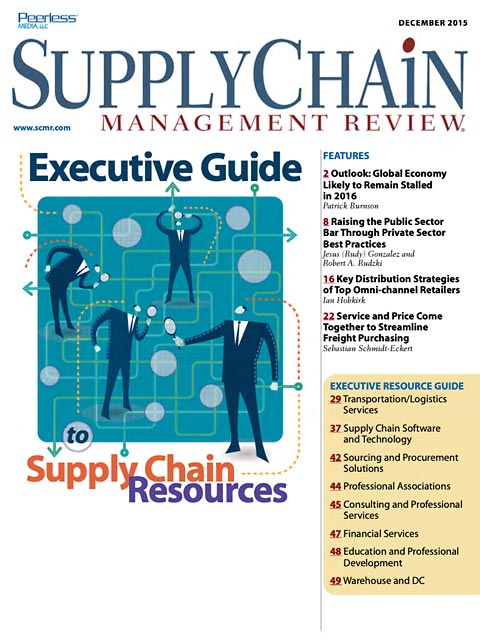Sorry, but your login has failed. Please recheck your login information and resubmit. If your subscription has expired, renew here.
December 2015
It’s December, and time once again for our annual Executive Guide to Supply Chain Resources. This is a comprehensive guide to services, products, and educational opportunities targeted specifically to supply chain professionals. The editors at Supply Chain Management Review wish all of our readers a successful year to come. Browse this issue archive.Need Help? Contact customer service 847-559-7581 More options
You see a new distribution center rising from the ground, you read the discouraging news that a local plant is closing, or you learn that a new company is breaking ground in an industrial park outside of town and think that there must be some inherently good or bad things about those locations. After all, aren’t the three most important things in real estate: location, location, location? Maybe it’s the quality of the site, access to the highway, tax incentives, or the cost and availability of labor. But what happened prior to this? Which factors caused the company to get interested in that location, or to get out of Dodge, in the first place? Why did an organization focus on that part of the country, at this point in time and with those site, building, and workforce requirements? How did that location fit into an overall network or supply chain network strategy, or, alternatively, what changed to make it a less optimal location?
You might think that there is one set of rules to help companies optimize their networks and enable their supply chain strategies, but in reality, the answers to those questions vary by industry and how a company goes to market to service its customers. Often, the reasons are different than you might think. Let’s look at some of the key decision drivers in network optimization and how they often vary by industry.
It’s Not the Building
Let’s start by looking at something that doesn’t matter all that much: the building you saw rising from the ground and the piece of ground from which it is rising. To anyone who has lived through the experience of building their dream house on the perfect piece of land, that sounds counterintuitive because people invest so much time, energy, and money in getting everything just right. But the truth is that in a supply chain network: “Real estate is a rounding error.”
 |
This complete article is available to subscribers
only. Click on Log In Now at the top of this article for full access. Or, Start your PLUS+ subscription for instant access. |
SC
MR
Sorry, but your login has failed. Please recheck your login information and resubmit. If your subscription has expired, renew here.
December 2015
It’s December, and time once again for our annual Executive Guide to Supply Chain Resources. This is a comprehensive guide to services, products, and educational opportunities targeted specifically to supply chain… Browse this issue archive. Access your online digital edition. Download a PDF file of the December 2015 issue.
 |
Download Article PDF |
You see a new distribution center rising from the ground, you read the discouraging news that a local plant is closing, or you learn that a new company is breaking ground in an industrial park outside of town and think that there must be some inherently good or bad things about those locations. After all, aren't the three most important things in real estate: location, location, location? Maybe it's the quality of the site, access to the highway, tax incentives, or the cost and availability of labor. But what happened prior to this? Which factors caused the company to get interested in that location, or to get out of Dodge, in the first place? Why did an organization focus on that part of the country, at this point in time and with those site, building, and workforce requirements? How did that location fit into an overall network or supply chain network strategy, or, alternatively, what changed to make it a less optimal location?
You might think that there is one set of rules to help companies optimize their networks and enable their supply chain strategies, but in reality, the answers to those questions vary by industry and how a company goes to market to service its customers. Often, the reasons are different than you might think. Let’s look at some of the key decision drivers in network optimization and how they often vary by industry.
It's Not the Building
Let’s start by looking at something that doesn’t matter all that much: the building you saw rising from the ground and the piece of ground from which it is rising. To anyone who has lived through the experience of building their dream house on the perfect piece of land, that sounds counterintuitive because people invest so much time, energy, and money in getting everything just right. But the truth is that in a supply chain network: “Real estate is a rounding error.”
 |
SUBSCRIBERS: Click here to download PDF of the full article. |
SC
MR

Latest Supply Chain News
Latest Podcast

 Explore
Explore
Latest Supply Chain News
- Strengthening customer fulfillment: Building a strategic stakeholder network
- The hard job of teaching soft skills
- Trump picks former Wisconsin congressman Sean Duffy for DOT secretary
- Made in Mexico, manufactured by China
- Retail sales see gains in October, reports Commerce and NRF
- Balancing green and speed: Home delivery insights from the pandemic era
- More latest news
Latest Resources

Subscribe

Supply Chain Management Review delivers the best industry content.

Editors’ Picks





